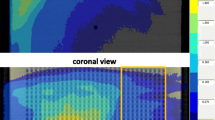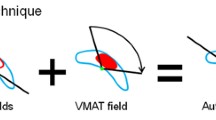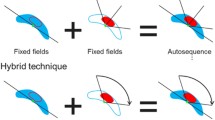Abstract
Objective
The aim of this study was to assess the feasibility of flattening filter-free (FFF) photon beams in hybrid intensity-modulated radiation therapy (H-IMRT) and hybrid volumetric modulated arc therapy (H-VMAT) for left-sided whole-breast radiation therapy with a boost volume (RT) using a hypofractionated dose regimen.
Patients and methods
RT plans of 25 patients with left-sided early-stage breast cancer were created with H‑IMRT and H‑VMAT techniques under breath-hold conditions using 6‑MV FFF beams. In hybrid techniques, three-dimensional conformal radiotherapy (3DCRT) plans were kept as base-dose plans for the VMAT and IMRT plans. In addition, H‑IMRT in step-and-shoot mode was also calculated to assess its achievability with FFF beams.
Results
All hybrid plans achieved the expected target coverage. H‑VMAT showed better coverage and homogeneity index results for the boost target (p < 0.002), while H‑IMRT presented better results for the whole-breast target (p < 0.001). Mean doses to normal tissues were comparable between both plans, while H‑IMRT reduced the low-dose levels to heart and ipsilateral lung (p < 0.05). H‑VMAT revealed significantly better results with regard to monitor units (MU) and treatment time (p < 0.001).
Conclusion
The 6‑MV FFF beam technique is feasible for large-field 3DCRT-based hybrid planning in whole-breast and boost planning target volume irradiation. For breath-hold patients, the H‑VMAT plan is superior to H‑IMRT for hypofractionated dose regimens, with reduced MU and treatment delivery time.



Similar content being viewed by others
References
Early Breast Cancer Trialists’ Collaborative Group (EBCTCG), Darby S, McGale P, Correa C et al (2011) Effect of radiotherapy after breast-conserving surgery on 10-year recurrence and 15-year breast cancer death: meta-analysis of individual patient data for 10,801 women in 17 randomised trials. Lancet 378:1707–1716
Clarke M, Collins R, Darby S et al (2005) Effects of radiotherapy and of differences in the extent of surgery for early breast cancer on local recurrence and 15-year survival: an overview of the randomised trials. Lancet 366:2087–2106
Vinh-Hung V, Verschraegen C (2004) Breast-conserving surgery with or without radiotherapy: pooled-analysis for risks of ipsilateral breast tumor recurrence and mortality. J Natl Cancer Inst 96:115–121
Bartelink H, Horiot JC, Poortmans PM et al (2007) Impact of a higher radiation dose on local control and survival in breast-conserving therapy of early breast cancer: 10-year results of the randomized boost versus no boost EORTC 22881–10882 trial. J Clin Oncol 25:3259–3265
Jones HA, Antonini N, Hart AM et al (2009) Impact of pathological characteristics on local relapse after breast-conserving therapy: a subgroup analysis of the EORTC boost versus no boost trial. J Clin Oncol 27:4939–4947
Dellas K, Vonthein R, Zimmer J et al (2014) Hypofractionation with simultaneous integrated boost for early breast cancer: results of the German multicenter phase II trial (ARO-2010-01). Strahlenther Onkol 190:646–653
Haviland JS, Owen RJ, Dewar JA et al (2013) The UK Standardisation of Breast Radiotherapy (START) trials of radiotherapy hypofractionation for treatment of early breast cancer: 10-year follow-up results of two randomised controlled trials. Lancet Oncol 4:1086–1094
Whelan TJ, Pignol JP, Levine MN et al (2010) Long-term results of hypofractionated radiation therapy for breast cancer. N Engl J Med 362:513–520
James ML, Lehman M, Hider PN et al (2010) Fraction size in radiation treatment for breast conservation in early breast cancer. Cochrane Database Syst Rev 7:CD003860. https://doi.org/10.1002/14651858.CD003860.pub3
Alford SL, Prassas GN, Vogelesang CR et al (2013) Adjuvant breast radiotherapy using a simultaneous integrated boost: clinical and dosimetric perspectives. J Med Imaging Radiat Oncol 57:222–229
Van Parijs H, Reynders T, Heuninckx K et al (2014) Breast conserving treatment for breast cancer: dosimetric comparison of different non-invasive techniques for additional boost delivery. Radiat Oncol 9:36
Bantema-Joppe EJ, Vredeveld EJ, de Bock GH et al (2013) Five year outcomes of hypofractionated simultaneous integrated boost irradiation in breast conserving therapy; patterns of recurrence. Radiother Oncol 108:269–272
Balaji K, Yadav P, BalajiSubramanian S et al (2018) Hybrid volumetric modulated arc therapy for chest wall irradiation: for a good plan, get the right mixture. Phys Med 52:86–92. https://doi.org/10.1016/j.ejmp.2018.06.641
Balaji K, Subramanian B, Yadav P et al (2016) Radiation therapy for breast cancer: literature review. Med Dosim 41(3):253–257. https://doi.org/10.1016/j.meddos.2016.06.005
Filippi AR, Ragona R, Piva C et al (2015) Optimized volumetric modulated arc therapy versus 3D-CRT for early stage mediastinal Hodgkin lymphoma without axillary involvement: a comparison of second cancers and heart disease risk. Int J Radiat Oncol Biol Phys 92(1):161–168. https://doi.org/10.1016/j.ijrobp.2015.02.030
Mayo CS, Urie MM, Fitzgerald TJ (2005) Hybrid IMRT plans–concurrently treating conventional and IMRT beams for improved breast irradiation and reduced planning time. Int J Radiat Oncol Biol Phys 61:922–932. https://doi.org/10.1016/j.ijrobp.2004.10.033
Jeulink M, Dahele M, Meijnen P et al (2015) Is there a preferred IMRT technique for left-breast irradiation? J Appl Clin Med Phys 16:197–205. https://doi.org/10.1120/jacmp.v16i3.5266
Chen YG, Li AC, Li WY et al (2017) The feasibility study of a hybrid coplanar arc technique versus hybrid intensity-modulated radiotherapy in treatment of early-stage left-sided breast cancer with simultaneous-integrated boost. J Med Phys 42(1):1–8. https://doi.org/10.4103/jmp.JMP_56_17
Lin J, Yeh D, Yeh H et al (2015) Dosimetric comparison of hybrid volumetric-modulated arc therapy, volumetric-modulated arc therapy and intensity-modulated radiation therapy for left-sided early breast cancer. Med Dosim 40(3):262–267. https://doi.org/10.1016/j.meddos.2015.05.003
BalajiSubramanian S, Balaji K, Thirunavukarasu M et al (2016) Bilateral breast irradiation using hybrid Volumetric Modulated Arc Therapy (h-VMAT) technique: a planning case report. Cureus 8(12):e914. https://doi.org/10.7759/cureus.91424
Aly MM, Glatting G, Jahnke L et al (2015) Comparison of breast simultaneous integrated boost (SIB) radiotherapy techniques. Radiat Oncol 10:139. https://doi.org/10.1186/s13014-015-0452-2
Jost V, Kretschmer M, Sabatino M et al (2015) Heart dose reduction in breast cancer treatment with simultaneous integrated boost: comparison of treatment planning and dosimetry for a novel hybrid technique and 3D-CRT. Strahlenther Onkol 191:734–741
Kragl G, Wetterstedt S, Knausl B et al (2009) Dosimetric characteristics of 6 and 10 MV unflattened photonbeams. Radiother Oncol 93(1):141–146
Sharma SD (2011) Unflattened photon beams from the standard flattening filter free accelerators for radiotherapy: advantages, limitations and challenges. J Med Phys 36(3):123–125
Georg D, Knoos T, McClean B (2011) Current status and future perspective of flattening filter free photon beams. Med Phys 38(3):1280–1293
Spruijt KH, Dahele M, Cuijpers JP et al (2013) Flattening filter free vs flattened beams for breast irradiation. Int J Radiat Oncol Biol Phys 85(2):506–513. https://doi.org/10.1016/j.ijrobp.2012.03.040
Subramaniam S, Thirumalaiswamy S, Srinivas C et al (2012) Chest wall radiotherapy with volumetric modulated arcs and the potential role of flattening filter free photon beams. Strahlenther Onkol 188:484–491. https://doi.org/10.1007/s00066-012-0075-6
Dobler B, Maier J, Knott B et al (2016) Second Cancer Risk after simultaneous integrated boost radiation therapy of right sided breast cancer with and without flattening filter. Strahlenther Onkol 192:687–695. https://doi.org/10.1007/s00066-016-1025-5
Bahrainy M, Kretschmer M, Jost V et al (2016) Treatment of breast cancer with simultaneous integrated boost in hybrid plan technique. Strahlenther Onkol 192:333–341. https://doi.org/10.1007/s00066-016-0960-5
White J, Tai A, Arthur D et al (2019) RTOG breast cancer atlas for radiation therapy planning: consensus definitions. https://www.rtog.org/CoreLab/ContouringAtlases/BreastCancerAtlas.aspx. Accessed 15 Apr 2019
Nicolini G, Fogliata A, Clivio A et al (2011) Planning strategies in volumetric modulated arc therapy for breast. Med Phys 38:4025–4031
Nakamura JL, Verhey LJ, Smith V et al (2001) Dose conformity of gamma knife radiosurgery and risk factors for complications. Int J Radiat Oncol Biol Phys 51(5):1313–1319
International Commission on Radiation Units and Measurements (2010) ICRU Report 83: prescribing recording and reporting photon beam intensity modulated radiation therapy (IMRT). ICRU Rep 10(1):1–92
Ohtakara K, Hayashi S, Hoshi H (2011) Dose gradient analyses in linac-based Intracranial stereotactic radiosurgery using Paddick’s gradient index: consideration of the optimal method for plan evaluation. J Radiat Res 52:592–599. https://doi.org/10.1269/jrr.11005
Kundrat P, Remmele J, Rennau H (2019) Minimum breast distance largely explains individual variability in doses to contralateral breast from breast-cancer radiotherapy. Radiother Oncol 131:186–191. https://doi.org/10.1016/j.radonc.2018.08.022
Koulis TA, Phan T, Olivotto IA (2015) Hypofractionated whole breast radiotherapy: current perspectives. Breast Cancer 7:363–370. https://doi.org/10.2147/BCTT.S81710
Kim KS, Shin KH, Choi N, Lee S (2016) Hypofractionated whole breast irradiation: new standard in early breast cancer after breast-conserving surgery. Radiat Oncol J 34(2):81–87. https://doi.org/10.3857/roj.2016.01697
Bentzen SM, Agrawal RK, Aird EG et al (2008) The UK standardisation of breast radiotherapy (START) Trial A of radiotherapy hypofractionation for treatment of early breast cancer: a randomised trial. Lancet 9:331–341. https://doi.org/10.1016/S1470-2045(08)70077-9
Bentzen SM, Agrawal RK, Aird EG et al (2008) The UK standardisation of breast radiotherapy (START) Trial B of radiotherapy hypofractionation for treatment of early breast cancer: a randomised trial. Lancet 371:1098–1107. https://doi.org/10.1016/S0140-6736(08)60348-7
Agrawal RK, Alhasso A, BarrettLee PJ et al (2011) First results of the randomised UK FAST Trial of radiotherapy hypofractionation for treatment of early breast cancer (CRUKE/04/015). Radiother Oncol 100:93–100. https://doi.org/10.1016/j.radonc.2011.06.026
Brunt AM, Wheatley D, Yarnold J et al (2016) Acute skin toxicity associated with a 1-week schedule of whole breast radiotherapy compared with a standard 3‑week regimen delivered in the UK FAST-Forward Trial. Radiother Oncol 120:114–118. https://doi.org/10.1016/j.radonc.2016.02.027
Scorsetti M, Alongi F, Fogliata A et al (2012) Phase i–ii study of hypofractionated simultaneous integrated boost using volumetric modulated arc therapy for adjuvant radiation therapy in breast cancer patients: a report of feasibility and early toxicity results in the first 50 treatments. Radiat Oncol 7:145
Zhou S, Zhu X, Zhang M et al (2016) Estimation of internal organ motion-induced variance in radiation dose in non-gated radiotherapy. Phys Med Biol 61:8157–8179. https://doi.org/10.1088/0031-9155/61/23/8157
Ramasubramanian V, Balaji K, Balaji Subramanian S et al (2019) Hybrid volumetric modulated arc therapy for whole breast irradiation: a dosimetric comparison of different arc designs. Radiol med 124(6):546–554. https://doi.org/10.1007/s11547-019-00994-1
Jin G, Chen L, Deng X et al (2013) A comparative dosimetric study for treating left-sided breast cancer for small breast size using five different radiotherapy techniques: conventional tangential field, filed-in-filed, Tangential-IMRT, Multi-beam IMRT and VMAT. Radiat Oncol 8:89
Viren T, Heikkilä J, Myllyoja K et al (2015) Tangential volumetric modulated arc therapy technique for left-sided breast cancer radiotherapy. Radiat Oncol 10:79
Haciislamoglu E, Colak F, Canyilmaz E et al (2015) Dosimetric comparison of left-sided whole-breast irradiation with 3DCRT, forward-planned IMRT, inverse-planned IMRT, helical tomotherapy, and volumetric arc therapy. Phys Med 31(4):360–367. https://doi.org/10.1016/j.ejmp.2015.02.005
Wang Y, Vassil A, Tendulkar R et al (2014) Feasibility of using nonflat photon beams for whole-breast irradiation with breath hold. J Appl Clin Med Phys 15(1):4397. https://doi.org/10.1120/jacmp.v15i1.4397
Hall EJ (2006) Intensity-modulated radiation therapy, protons, and the risk of second cancers. Int J Radiat Oncol Biol Phys 65(1):1–7. https://doi.org/10.1016/j.ijrobp.2006.01.027
Darby SC, Ewertz M, McGale P et al (2013) Risk of ischemic heart disease in women after radiotherapy for breast cancer. N Engl J Med 368(11):987–998. https://doi.org/10.1056/NEJMoa1209825
Gagliardi G, Constine LS, Moiseenko V et al (2010) Radiation dose-volume effects in the heart. Int J Radiat Oncol Biol Phys 76(3):S77–S85. https://doi.org/10.1016/j.ijrobp.2009.04.093
Marks LB, Bentzen SM, Deasy JO et al (2010) Radiation dose-volume effects in the lung. Int J Radiat Oncol Biol Phys 76(3):70–76. https://doi.org/10.1016/j.ijrobp.2009.06.091
Blom GU, Wennberg B, Svane G et al (2010) Reduction of radiation pneumonitis by V20-constraints in breast cancer. Radiat Oncol 5:99. https://doi.org/10.1186/1748-717X-5-99
Mah D, Miller E, Kuo H et al (2011) Flattening filter free beams for 3D breast planning. Med Phys 38:3632
Author information
Authors and Affiliations
Corresponding author
Ethics declarations
Conflict of interest
K. Balaji, S. Balaji Subramanian, K. Sathiya, M. Thirunavukarasu, C. Anu Radha, and V. Ramasubramanian declare that they have no competing interests.
Ethical standards
The institutional scientific and ethics board has approved this study. This article does not contain any studies with human participants performed by any of the authors. Informed consent was waivered by the ethics board of the institute as this is a retrospective study with no human involved. For this type of study, formal consent is not required.
Rights and permissions
About this article
Cite this article
Balaji, K., Balaji Subramanian, S., Sathiya, K. et al. Hybrid planning techniques for hypofractionated whole-breast irradiation using flattening filter-free beams. Strahlenther Onkol 196, 376–385 (2020). https://doi.org/10.1007/s00066-019-01555-1
Received:
Accepted:
Published:
Issue Date:
DOI: https://doi.org/10.1007/s00066-019-01555-1




